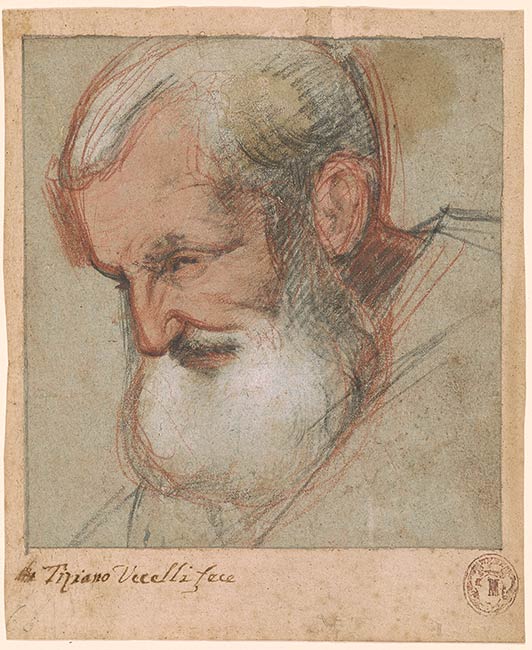
Jacopo Bassano initially trained in his father’s workshop in Bassano del Grappa, some sixty kilometers northwest of Venice, but then moved to Venice for a few years beginning in 1534. The rest of his life was spent in his native town, where he ran a large workshop that in time was to include his sons Francesco, Leandro, Gerolamo, and Giovanni Battista. An artist of remarkable originality, Bassano excelled as a painter of animals and naturalistic still-life details. His paintings of biblical subjects placed in con temporary rustic settings provided a vital impulse to the development of genre painting.
As a draftsman, Bassano was the first to make extensive and consistent use of colored chalks, often also referred to as pastels.1 The technique had been explored by earlier artists, most famously by Leonardo in his female portrait of ca. 1500, said to be of Isabella d’Este, in the Louvre. In most of these early instances, chalk was used only for localized descriptive coloring. It was Bassano who left the earliest sizable corpus of drawings, including individual figure studies and entire compositions, in this technique. It is hard to determine, however, how and when exactly the artist developed an interest in multicolored chalks and pastels, as these media were virtually absent in sixteenth-century Venice— so much so that Bassano’s work in the medium remains without real parallel in the graphic oeuvre of his contemporaries.2 As in the present example, Jacopo wielded the chalk much more freely than his predecessors, achieving greater naturalistic and emotive effects.
Despite an old attribution to Titian inscribed on the mount, the present drawing is Bassano’s study for the head of St. Joseph in his painting of the Flight into Egypt, as was first recognized by Roger Rearick.3 The painting is from the artist’s early maturity and is usually dated to the early 1540s on grounds of style. It was commissioned for the church of the Santissima Annunziata in Ancona, from where it was sold in 1801, and is now in the Toledo Museum of Art, Ohio.4
The artist must have rubbed varying combinations of wetted red and white chalk across the surface of the blue paper, possibly spreading these with the tips of his fingers to build up the flesh tones of the face and ear and the silvery white of the hair and beard. Areas of particular density, such as the crisp white on the beard at right, were probably applied with a brush. Atop this, Bassano drew thick parallel lines of grainy black chalk to approximate the shadows cast onto the left side of Joseph’s face and additional black lines to mark the limits of his cloak and shoulder. Lastly, he made corrections to the proportions with vigorous heavy red chalk lines that slightly enlarge the back of the head and give definition to the brow and nose yet at the same time impart a sense of spontaneous movement and energy to the study. Such free, robust lines, as well as the two roundish light-brown oil stains in the upper right quadrant of the sheet, reveal this to be a workshop drawing, an exemplar to be kept for future study or for use in a painting rather than to be presented to a patron or collector.
The keenly observed grim expression of the aged Joseph of the drawing is deftly translated into the painting, where his bowed head and forceful mien convey the character’s unflagging determination in the face of the long and arduous journey ahead. The figural type of this astonishingly naturalistic head recurs several times in Bassano’s work, leaving one to wonder if the artist based it on a live model, possibly a person in his family or studio. Joseph’s facial features reappear, for example, in Bassano’s Adoration of the Magi in the National Gallery of Scotland at Edinburgh,5 although the figure appears almost frontally rather than in the profile depicted here. Commissioned in 1542, that painting also shows Joseph with a wide face, heavy brow, deep corners indicative of a receding hairline, and a bushy beard with two prominent puffs.
—REP
Footnotes:
- See Bickendorf 1998. On Bassano’s use of pastels, see also McGrath 1997, 23, and McGrath 1998, 9n47.
- Bassano began experimenting with colored chalks in the late 1550s. On this topic, see Venice 2014–15, no. 25.
- The attribution of the sheet was first suggested in 1973 by Rearick at the time of the exhibition Drawings from the Collection of Lore and Rudolf Heinemann; see New York 1973, no. 27.
- Bassano del Grappa and Fort Worth 1992–93, 275–77, no. 11; Beverley Louise Brown in Venice 1999, 480–81, no. 134.
- See Bassano del Grappa and Fort Worth 1992–93, no. 10.
Watermark: none.
Inscribed, on album page, at lower left, just beneath drawing, in pen and brown ink, "Tiziano Vecelli fece"; on verso of mount, at upper center, the number "65" has been inscribed in red chalk.
Heinemann, Rudolf J., former owner.
Heinemann, Lore, former owner.
Rhoda Eitel-Porter and and John Marciari, Italian Renaissance Drawings at the Morgan Library & Museum, New York, 2019, no. 65.
Selected references: New York 1973, no. 27; Rearick 1986, no. 4; Bassano del Grappa and Fort Worth 1992- 93, no. 82; Rearick 2001, 116.
Stampfle, Felice, and Cara D. Denison. Drawings from the Collection of Lore and Rudolf Heinemann. New York : Pierpont Morgan Library, 1973, no. 27, repr.
